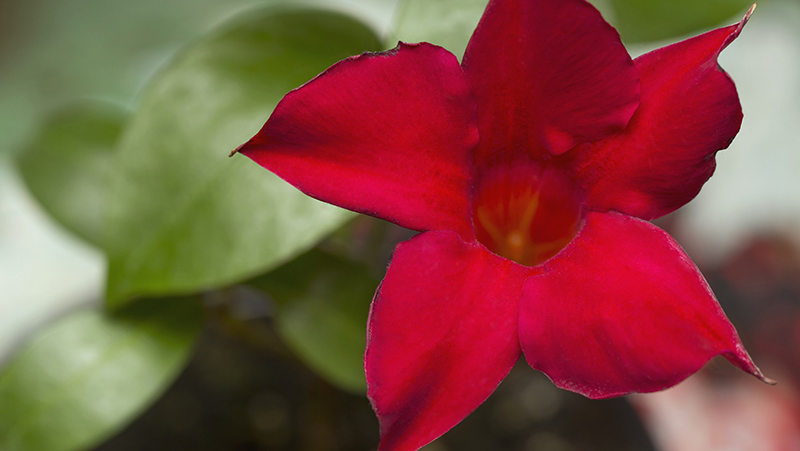Yates Account
Join now
Create a Yates account today!
Sign up to join the Yates Garden Club for monthly e-mails packed with seasonal inspiration, tips for success & exclusive promotions.
Plus if you’re a Garden Club member you can take part in the Yates Growing Community - a blog to share successes, get advice & win prizes in fun challenges along the way!

Forgot password
Enter the email address associated with your account, and we'll email you a new password.

Mandevillas or Dipladenias (Mandevilla spp.) are very popular, easy-care flowering shrubs and climbers! They are loved for their long lasting flowers and flowering period with their red, pink, white and yellow flowers. Their easy-care nature and drought hardiness make them perfect for container gardens and pots.
How to grow Mandevilla in a garden
- Choose a position in full sun or part shade with well drained soil.
- Enrich the soil with Yates Thrive Natural Blood & Bone with Seaweed. If the soil is clay based, add gypsum and fork in well.
- Dig the planting hole twice as wide and to the same depth as the root-ball. Remove the plant from the container and gently tease the roots.
- Position in hole and backfill, gently firming down. Form a raised doughnut shaped ring around the plant, creating a well so that water will go where it’s needed most. Water in well.
- Mulch with an organic mulch like woodchip or pea straw, keeping it away from the base of the plant.
- Water deeply, once or twice a week, depending on weather conditions, allowing to dry out slightly in between waterings.
- During the growing and flowering season feed with Yates Thrive Rose & Flower Granular Plant Food. TIP: for an added boost apply Yates Thrive Natural Fish & Seaweed+ Plant Food Concentrate.

How to grow Mandevilla in a pot
- Choose a pot at least 300mm wide.
- Position in full sun or part shade.
- Fill the pot with quality potting mix, such as Yates Premium Potting Mix.
- Remove the plant from the container and gently tease the roots.
- Position in hole and backfill, gently firming down. Water in well.
- Water deeply, once or twice a week, depending on weather conditions, allowing to dry out slightly in between waterings.
- Feed with Yates Thrive Roses & Flowers Liquid Plant Food. TIP: for an added boost apply Yates Thrive Natural Fish & Seaweed+ Plant Food Concentrate.
Growing tips
- Avoid overwatering as Mandevillas hate wet feet.
- Ensure you provide the plant with plenty of sturdy support to grow on. Otherwise, tip prune to encourage a more shrub-like habit.
- For cooler climates try growing M. laxa. This deciduous variety produces fragrant summer flowers and can tolerate frosts down to -6°C. If it is damaged by the cold, cut back completely and it will re-shoot from the base.
- Some mandevillas are often referred to as dipladenias. These plants are considered to be forms of M. sanderii.
- Wear gloves when pruning to protect your skin from the milky sap.
Orange trumpet vine, with its brilliant cascading masses of orange tubular flowers, is one of the most spectacular winter flowering climbers.
Spring Stars
Spring Stars are a versatile addition to any garden with delightful lavender-blue, star shaped blooms.
Flax
Flaxes (Phormium spp.) are highly versatile plants which don't mind swampy or dry conditions. Great for large pots or planted en-masse in garden beds.
Proteas
Not just any old blossom, protea flowers are blooms with attitude. If you can give them full sun and reasonable drainage, proteas will love you.
Recommended products
Yates Thrive Rose & Flower Granular Plant Food
Specially formulated to grow all types of flowers. With high potassium for large & abundant flowers, added calcium & iron for stronger flowers.
Yates Thrive Roses & Flowers Liquid Plant Food
Provides your flowers & roses with the balanced nutrients they require for healthy growth and flower production.
Yates Premium Potting Mix
A premium potting mix, ideal for all potted plants and shrubs, including ornamentals, fruit trees, vegies and herbs.
Yates Thrive Natural Blood & Bone with Seaweed
A certified organic garden input boosted with NZ Seaweed to gently nourish plants, enrich the soil and encourage a strong healthy root system.
















Share
Share this article on social media